NEAM to KSC
Report by Gary Moir
Sunday, 23 February 2003.
I drove from Philadelphia, PA, to
Windsor Locks, CT, this morning in time to see the last performance of
Alison Moncief's play The Wright Idea.
For the last few miles, I drove through very heavy rain, 1.6 inches
fell here today, and the play started just before I arrived.
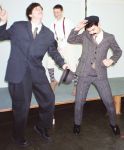
|
|
Orville, Wilbur, and the newsboy in a later day dance step.
|
The theme of the play was the genius and persistence
required for the Wright Brothers to uncover these secrets that nature
has preserved for them to discover. High school students played
Katherine, Wilbur and Orville in their first professional roles.
The play was made possible by a grant from the Connecticut chapter
of the AIAA organized by Egils
Vigants, a Pratt & Whitney engineer who is serving as the
AIAA Evolution of Flight
Coordinator for the New England Region. Pratt & Whitney also
partially funded the extended display of the Wright Flyer at the
New England Air Museum (NEAM)
through a contribution to the national organization.
Museum displays are impressive and growing.
They currently have over 80 aircraft on display. Displays have
excellent placards and descriptions of the aircraft and their
development. Volunteers are currently restoring a B-29 vertical
stabilizer fin.
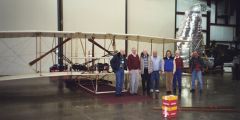
|
|
New England Air Museum staff and volunteers in front of the Flyer and the B-29 tail.
|
One of the museum supporters told me that a BA
Concorde airliner landed here at Bradley Airport today due to weather
limitations at JFK airport. This is one of the longest airfields
in the New England area, so it is the main alternate airport for the
Concorde.
Caroline d'Otreppe hosted a cast party after the
performance in her spectacular (soon to be) new Bed &
Breakfast. (She just started refurbishing her father's home after
acquiring it from his estate.) The variety of delicious hors
d'oeuvres, sandwiches, drinks and desserts was excellent. Their
player piano inspired several of the young ladies present to display
their own mastery of the piano. I hope to return as a paying
guest after they open next fall.
Tomorrow morning, I will join the NEAM team and the
WF transportation team to disassemble the Flyer and pack it into the
moving van for the trip to KSC.
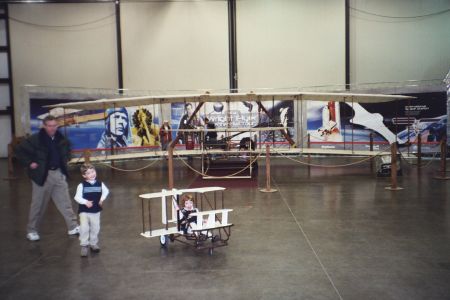
|
| Kiddy Flyer, the replica Flyer, and the Centennial tour display.
|
Monday, 24 February 2003.

|
|
Bert Konle helps break down the display truss frames in front of the Flyer truss wires.
|
Our truck driver, Bert Konle, and some of the local
volunteers were already starting to break down the display panels when
Tony Visser and I arrived at 8:30 am, expecting to be early for the
9:00 scheduled start. The disassembly went smoothly although
packing a 40' 4 wingspan aircraft and a 12' canard span aircraft in a
53' moving van almost requires a shoehorn.
The snow outside made a spectacular background for
the Flyer as we opened the museum doors to load the moving van.
We were very fortunate that this most severe snowstorm of this century
occurred the week before our move instead of during it. As it
was, Bert drove through the edges of storms with threats of floods from
melting snows all the way to Florida.
The people at the New England Air Museum
were wonderful hosts for both our aircraft and our team throughout our
stay in Windsor Locks. We understand that they set attendance
records while the aircraft was there and expect public's enhanced
awareness of their displays to affect their programs throughout this
Centennial of Flight year. I offer my heartfelt thanks and
respect to both the NEAM staff and their patrons.
Tuesday, 25 February 2003.
Today my wife, Jane, and I are taking the train from
Philadelphia to Richmond, VA, where we will rent a car to drive to the
Outer Banks and Kill Devil Hills, NC, the site of man's first
successful powered and controlled flight. The Amtrak coach has
many modern amenities, compared to the trains that Wilbur & Orville
used from Dayton to NC. Still, it is satisfying to use their same
mode of transportation.
Traveling on a train is quite a different experience
from either driving in a car or flying in a commercial airplane.
There is plenty of room to move around and to set up my computer with
the 110 V power supply. Scenes pass the windows at a rate that
one can think about the homes, businesses, cities, and rural areas, or
anything else one may fancy. (Isn't that a cool 19th century word and
concept?)
One recurring thought on this train trip is that the
Wrights lived in an age of rapidly developing technology that
contributed to their development of the first airplane. In this
case, the development of the railroad provided an economical mode of
transport for them and their machines. More than that, the
expanding demands of long distance trains and tracks were driving
mechanical and metallurgical engineering from the 1830's to the
1900's. I'll offer four examples of this technological
convergence below.
Octave Chanute was a practicing Civil Engineer who
suggested the wire-stayed Pratt truss as one of the most efficient
structural concepts for a low speed biplane aircraft. This truss
concept, shown in Figure 1, uses pre-tensioned diagonal wires to carry
vertical shear loads from the wing's lifting force and axial tension
and compression spars and struts to efficiently react bending moments
as axial loads. Wilbur's realization that the angles between
Pratt truss struts and spars could be changed by simply changing the
lengths of the diagonal wires, without noticeable changes in wire
tensions, was the innovation that allowed warping the wings to develop
the first aircraft with control of roll rotation. Coordinated
control of the roll and yaw (directional) rotations of the aircraft
were the basis of the Wright's patent and their greatest contribution
to the evolution of flight.
Railroad engines (and other steam engines) were the
first machines that simultaneously needed high repetitive forces in a
machine with moderate vehicle weight. This forced development of
higher quality steels and other materials and made those materials
available for other uses. Specifically, quality high strength
thin tubing facilitated the development of bicycle and automobile
frames. The Flyer uses thin-wall brazed tubing in the chain
spreaders and the propeller diamond frames only slightly thicker than
modern production bicycles.
Bicycles, motorcycles, and automobiles required even
lighter tubular structures, drive trains and engines than trains.
The bicycle tubing, wires, and adhesives used in the Flyer were true
enabling technologies.
The Wright's engine used an aluminum casting that
accidentally had a small amount of copper in the alloy, significantly
improving the strength of the casting. Economical production of
aluminum had only become possible since Charles Martin Hall and Paul
L.T. Heroult discovered the electrolytic process to refine it in
1886. In 1903 aluminum remained an exotic, but available
material. The Wrights built one of the first aluminum block
engines in just a few months!
Kill Devil Hills Visit
Wednesday, 26 February 2003.
The drive from Richmond to the Outer Banks area of
North Carolina is benefiting from the anticipated traffic of this
centennial year. Highways 168 and 158 from Norfolk south to Nags
Head are newly paved and widened 4 lane highways the full
distance. One can recognize the older impoverished farms and
businesses off the highway, but there are plenty of new homes and
businesses including typical shopping centers and schools. The
drive took less than 4 hours in clear weather and early evening traffic.
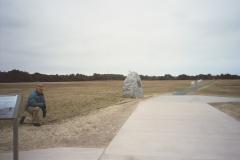
|
|
Gary Moir kneels at the start of the launching rail at Kill Devil Hills. Markers show the takeoff point and flight distances of the first four flights on 17 Dec 1903. The 852' fourth flight is a speck in the distance along the dark path.
|
The Outer Banks are a chain of sand dune islands 1
to 20 miles off the North Carolina shoreline with an inland passage
between them and the mainland. The Wrights found them by asking
the weather bureau for remote, sandy, sea level, locations with uniform
winds suitable for soaring an aircraft. (Soaring is flying into a
wind so that ground speed is reduced.) As Wilbur wrote to his
sister Katherine in 1900, We can't complain about the wind and blowing
sand since we asked for both.
Houses near the coastline are usually either on top
of or behind a 10-20 ft tall sand dune and built on log pilings as if
on stilts. Wilbur & Orville's reports of winds and surf on
the edge of two hurricanes give a good explanation for this
construction.
Trees and prickly pear cactus now grow around and on
the sand dunes of the Kill Devil Hills. On this wintry, blustery
day, there were never more than five cars in the parking lots or four
other couples walking around the monuments. Still, one needs to
see the barren sand dune photos to imagine the utter emptiness that the
Wrights experienced. It was good to see the area vacant now,
because large crowds are anticipated for the Centennial events.
Thursday, 27 February 2003
Our train ran about 2 hours late due to the
snow up north and the rains in the south. Still it was a fine way
to travel along the east coast. We rented a car in Orlando and
drove east 32 miles to our motel in Titusville. As we parked, we
found the Wright Flyer's Centennial Tour United Van Lines truck in the
parking lot where Bert Konle, the truck driver, was having the truck
washed & polished to remove the snow and grime of the drive from
the NEAM. His pride shows in the special care he takes of the
truck and aircraft. In the evening we met our other team members,
Marilyn Ramsey, Pam Leven, and John Latz.

|
|
The van and Centennial Tour decal in front of the Saturn 1B, Titan-Gemini, Thor Agena, and Atlas-Mercury displays.
|
Friday, 28 February 2003
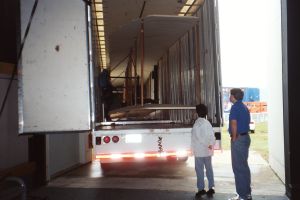
|
|
Bert Konle squeezes behind the Flyer in the truck at KSC as Pam Leven and John Latz watch. Notice how perfectly the Wrights sized the Flyer for transport in a modern moving van.
|
Our team met for breakfast, then drove south to the
Kennedy Space Center Visitors Center where we unloaded the Flyer into a
display area in the IMAX theater building. Bert left early to get
the truck into the Visitor Center before the crowds arrived. Tony
Visser hired a local four-man crew to help unload the Flyer and set up
the display. It was raining lightly as we unloaded the Flyer and
the undoped muslin wing covering on the starboard wing tip got slightly
moist and was temporarily slightly discolored. I therefore did a
full walk-around inspection of the Flyer when we finished the setup and
found the plane in excellent condition with just a few minor cosmetic
squawks.
Several photographers and a TV cameraman arrived as
we completed the setup. I graphically showed the similarity of
the steel truss frames around the display panels and the Wright Flyer's
Pratt Truss structure to the TV with Tony in the foreground. I
don't know if they used the bit, even after I explained to the
cameraman how the Flyer's diagonal truss wires allowed the Wrights to
warp the wings with very small control forces. (The wires to the
upper wing tips are connected together through the hip cradle so one
only has to apply a few pounds of force to overcome secondary effects
when you displace the cradle to cause a roll. The loads from one
wing are automatically balanced by the loads from the other wing.)
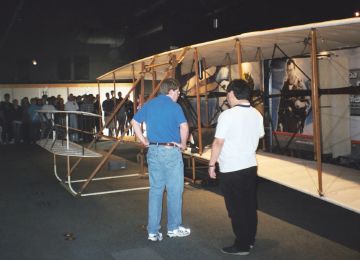
|
|
AIAA Wright Flyer display in the IMAX Theater exhibit area almost assembled with John Latz discussing the replica with a photographer. In the background are the students from Palm Bay High School.
|
About 3 p.m., a group of students from Palm Bay High
School arrived to see the Flyer. Marilyn Ramsey gave a talk about
our Project and the history of this Flyer. I told them about some
of the Wright's engineering feats and their emphasis on safety.
These facts include the demonstrated capability of the wing to support
over 4 times the weight of the aircraft, the concept of soaring into a
headwind to reduce speed over the soft sand, clever features of the gas
tank to prevent spillage, and the impact protection afforded by the
canard structure.
Many IMAX theatergoers walked through the display
area while waiting for or exiting from a show. Each of us spent
some time on Friday and Saturday talking with visitors and enjoying the
growing awareness that 2003 is the Centennial of the first controlled
powered flight.
As Bert moved the trailer to the entry area, where
it will serve as a billboard for our display, I took a photograph of
the truck and the Saturn 1B-Apollo display. I am astonished at
the contrast of the Wright Flyer with the rockets and spacecraft that I
helped develop to land on the Moon just 66 years after the First Flight
and just 100 years after the Transcontinental Railroad was
completed. I look forward to helping expand mankind's unlimited
future and hope this display may inspire the leaders of tomorrow to
realize that potential.
Copyright 2002, AIAA Wright Flyer Project,
all rights reserved.








